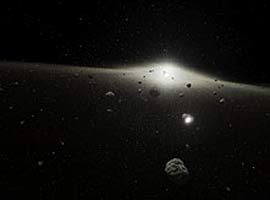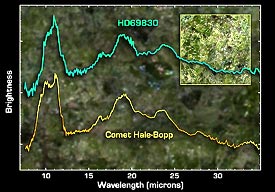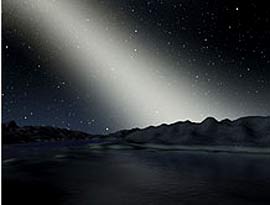
This artist's concept shows a massive asteroid belt in orbit around a star with an age and luminosity similar to our Sun. The Spitzer Space Telescope has apparently found such a belt around the star HD 69830.
Courtesy NASA / JPL-Caltech / Tim Pyle (SSC).
Astronomers have enjoyed considerable success in recent years searching for objects around other stars that are analogous to those in our solar system. They have discovered about 160 extrasolar planets and numerous debris disks of cold dust around young stars that suggest the presence of colliding comets and Kuiper Belt objects. In recent times several teams have reported evidence for warm dust generated by collisions in the asteroid belts of other stars.
Today, a team of astronomers using the Spitzer Space Telescope announced the discovery of a dense asteroid belt closely orbiting a star very similar to the Sun in age and mass. The group, led by Charles Beichman (Caltech), used Spitzer's infrared capability to detect the heat emission of a dusty disk around the 6th-magnitude star HD 69830 in Puppis. This disk indicates a rubble ring roughly 25 times more massive than our solar system's asteroid belt. Based on the temperature range of the dust — from room temperature to that of a hot oven — it must reside in a belt very close to the star to a distance approximately that of Venus's orbit around the Sun.
"What we're seeing for the first time is an asteroid belt around a star much like our Sun," says Beichman. "Asteroid belts might mark either the construction sites that accompany the formation of rocky planets, junkyards after the formation of planets, or they may mark places where for some reason or another material couldn't assemble to form planets at all."
This is not the first detection of an exo-asteroid belt. In 2001 Christine H. Chen (Jet Propulsion Laboratory) and Michael Jura (UCLA) reported a similar dusty disk around the star Zeta Leporis. Earlier this year Inseok Song (Gemini Observatory), Ben M. Zuckerman and Eric Becklin(UCLA), and Alycia J. Weinberger (Carnegie Institution of Washington) announced an even dustier disk around HIP 8920. Both of these stars are only several hundred million years old and Zeta Leporis is more massive than the Sun. HD 69830, in contrast, is several billion years old and just slightly less massive than the Sun.

The spectrum of the warm dust around HD 69830 is remarkably similar to the spectrum of Comet Hale-Bopp. This suggests they are made of similar materials. HD 69830's dust is rich in a magnesium-silicate mineral called forsterite, which often forms in high-temperature environments (such as volcanos) on Earth. This suggests but does not prove that the dust around HD 69830 originated in a violent asteroid collision.
Courtesy NASA / JPL-Caltech / Charles Beichman.
HD 69830's warm dust is probably the signature of smashups in its asteroid belt, although there is a small chance it could have resulted from the recent passage close to the star of a very large comet. But Weinberger points out that it remains uncertain whether the dust around HD 69830, Zeta Leporis, and HIP 8920 comes from recent large-scale collisions that have pulverized asteroids to dust, or less-violent collisions in asteroid belts much more massive than our own. "We could be looking at massive asteroids belts, or we could be looking at these stars right after a very big collision," says Weinberger. "You can't tell just by looking at the dustiness of the star."
What astronomers do know is that dust cannot survive for very long close to a star, especially the very small grains around HD 69830. Radiation pressure from starlight blows small dust grains out of the system in just a few tens of years. Larger dust grains, in contrast, slowly spiral into the star over several thousand years in a process known as the Poynting-Robertson effect. The presence of dust around a star thus implies a source of replenishment, most likely from asteroids slamming into one another.
Beichman's team found warm dust around only 1 of the 85 stars targeted so far by Spitzer, which is not surprising if large amounts of circumstellar dust are produced in rare, violent asteroidal collisions. The lack of dust around most stars is good news for future astronomers who will attempt to image Earth-like exoplanets with proposed space-based observatories such as NASA's Terrestrial Planet Finder (TPF) and the European Space Agency's Darwin.
"Dust reflects starlight and emits at infrared wavelengths, so it will overwhelm light from Earthlike planets that TPF and Darwin will search for," says Geoff Marcy (University of California, Berkeley), coleader of the team that has discovered more than half the known exoplanets. "So the nondetection of dust for the vast majority of the 85 stars suggests that most Sun-like stars won't offer such dusty obstacles to the detection of other Earths."

This artist concept shows what the zodiacal light might look like from a planet orbiting HD 69830. This star's asteroid belt has 25 times more material than our own asteroid belt, so the zodiacal light would be 1,000 times brighter than our own zodiacal light, which means it would outshine the Milky Way. Currently, there is no evidence for any planets around HD 69830.
Courtesy NASA / JPL-Caltech / Robert Hurt (SSC).
Our own solar system contains an analogous, though sparse, dust disk. We see it as the zodiacal light, dimly visible in a clear, unpolluted sky after dusk or before dawn. Because of its enormous size, the zodiacal light is actually the brightest "object" in the solar system after the Sun. Astronomers estimate that about half of it comes from disintegrating comets and half from collisions in our asteroid belt.
 0
0
Comments
You must be logged in to post a comment.